Dolphin/File Management/el: Difference between revisions
Created page with "Από την KDE 4.1 παρέχεται η δυνατότητα της δεντρικής προβολής των φακέλων. Σε αυτή τη λειτουργία το..." |
Created page with "=== Στήλες ===" |
||
| Line 116: | Line 116: | ||
Από την KDE 4.1 παρέχεται η δυνατότητα της δεντρικής προβολής των φακέλων. Σε αυτή τη λειτουργία το σύμβολο συν εμφανίζεται δίπλα στον φάκελο. Το σύμβολο συν έχει αντικατασταθεί από το > στις νεότερες εκδόσεις του KDE. Κάνοντας κλικ στο σύμβολο αυτό, ο φάκελος αναπτύσσεται και εμφανίζονται τα περιεχόμενα αρχεία και οι φάκελοι, κατά μια εσοχή προς τα δεξιά. Κάνοντας και πάλι κλικ στο σύμβολο, που τώρα είναι το πλην (ή, στις τελευταίες εκδόσεις, ένα βέλος που δείχνει προς τα κάτω), η επέκταση κλείνει. Εννοείται πως η προβολή δέντρου μπορεί να χρησιμοποιηθεί σε όσους φακέλους επιθυμείτε. Στις τελευταίες κυκλοφορίες του KDE, η προβολή δέντρου είναι προκαθορισμένα ενεργοποιημένη, αλλά μπορεί να απενεργοποιηθεί επιλέγοντας <menuchoice>Έλεγχος -> Διαμόρφωση Dolphin -> Λειτουργίες προβολής -> Λεπτομέρειες </menuchoice> και απενεργοποιώντας το <menuchoice>Επεκτάσιμοι φάκελοι</menuchoice>. | Από την KDE 4.1 παρέχεται η δυνατότητα της δεντρικής προβολής των φακέλων. Σε αυτή τη λειτουργία το σύμβολο συν εμφανίζεται δίπλα στον φάκελο. Το σύμβολο συν έχει αντικατασταθεί από το > στις νεότερες εκδόσεις του KDE. Κάνοντας κλικ στο σύμβολο αυτό, ο φάκελος αναπτύσσεται και εμφανίζονται τα περιεχόμενα αρχεία και οι φάκελοι, κατά μια εσοχή προς τα δεξιά. Κάνοντας και πάλι κλικ στο σύμβολο, που τώρα είναι το πλην (ή, στις τελευταίες εκδόσεις, ένα βέλος που δείχνει προς τα κάτω), η επέκταση κλείνει. Εννοείται πως η προβολή δέντρου μπορεί να χρησιμοποιηθεί σε όσους φακέλους επιθυμείτε. Στις τελευταίες κυκλοφορίες του KDE, η προβολή δέντρου είναι προκαθορισμένα ενεργοποιημένη, αλλά μπορεί να απενεργοποιηθεί επιλέγοντας <menuchoice>Έλεγχος -> Διαμόρφωση Dolphin -> Λειτουργίες προβολής -> Λεπτομέρειες </menuchoice> και απενεργοποιώντας το <menuchoice>Επεκτάσιμοι φάκελοι</menuchoice>. | ||
=== | === Στήλες === | ||
View mode ''"Columns"'' was inspired by the file manager '''Finder''' of Mac OS X. Entering a sub folder did not replace the current folder view but the content of the sub folder was listed in an additional column next to the column of the parent folder. This could be used for several hierarchies, so that you could navigate in an easy and fast way in the file system. Since KDE 4.8, view mode ''"Columns"'' has been dropped and will not be available in future '''Dolphin''' releases. | View mode ''"Columns"'' was inspired by the file manager '''Finder''' of Mac OS X. Entering a sub folder did not replace the current folder view but the content of the sub folder was listed in an additional column next to the column of the parent folder. This could be used for several hierarchies, so that you could navigate in an easy and fast way in the file system. Since KDE 4.8, view mode ''"Columns"'' has been dropped and will not be available in future '''Dolphin''' releases. | ||
Revision as of 12:49, 18 March 2013
Εξερευνήστε τον Dolphin
Το πρώτο τμήμα αποτελεί μια ξενάγηση στον Dolphin. Το δεύτερο τμήμα ασχολείται με τους διάφορους τύπους σελιδοδεικτών. Στο τρίτο κομμάτι συζητάμε για τη διαχείριση αρχειοθηκών. Τέλος, ρίχνουμε μια σε 'Περισσότερα ενδιαφέροντα πράγματα'. Μπορείτε να κάνετε κλικ στις εικόνες για να τις προβάλετε σε μεγέθυνση.
Γενικές πληροφορίες
Dolphin ή Konqueror;
Ο συγκεκριμένος οδηγός περιγράφει τον Dolphin για την έκδοση KDE SC 4. Ο Konqueror ήταν ο πρότυπος διαχειριστής αρχείων στις εκδόσεις 2 και 3 του KDE . Μπορείτε να χρησιμοποιήσετε τον Konqueror ως πρότυπο διαχειριστή αρχείων και στην KDE SC 4. Για να το κάνετε αυτό, από την KDE SC 4.2 κι εμπρός, ανοίξτε τις Ρυθμίσεις συστήματος και πηγαίνετε στο άρθρωμα . Μπορείτε να επιλέξετε τον Konqueror ή μια γκάμα άλλων εφαρμογών ως τον προκαθορισμένο διαχειριστή αρχείων.
Εισαγωγή στον Dolphin
Ο Dolphin είναι ο διαχειριστής αρχείων του KDE Software Compilation.
Θα σας δείξουμε πως να χρησιμοποιείτε τον Dolphin για τυπικές εργασίες διαχείρισης αρχείων και πως να τον διαμορφώσετε σύμφωνα με τις ανάγκες σας.
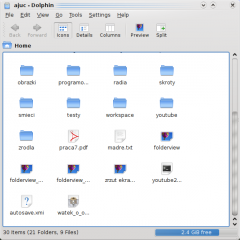
Όταν ανοίγετε τον Dolphin από το μενού Kickoff εμφανίζεται η αρχική σας τοποθεσία - προκαθορισμένα, η τοποθεσία αυτή είναι ο κατάλογος Αρχική.
Για να ανοίξετε ένα αρχείο ή για να πάτε σε έναν φάκελο απλά κάντε κλικ πάνω του. (Αυτό μπορείτε να το αλλάξετε σε διπλό κλικ στις , εφόσον προτιμάτε. Ορισμένες διανομές θέτουν τη λειτουργία με το διπλό κλικ ως την προεπιλεγμένη.) Στο KDE 4.5 αυτό μπορεί να γίνει από τις
Για να επιλέξετε και να από-επιλέξετε αρχεία και φακέλους περάστε με το ποντίκι πάνω από το εικονίδιό τους και κάντε κλικ στο σύμβολο συν, το οποίο αναδύθηκε, για επιλογή ή στο σύμβολο πλην για από-επιλογή. Όπως παρακάτω:
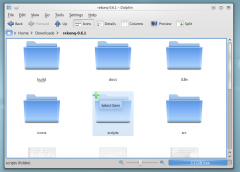
Όταν κάνετε κλικ στο σύμβολο συν, το συγκεκριμένο αρχείο ή φάκελος προστίθεται στα επιλεγμένα. Μπορείτε να επιλέξετε πολλαπλά αρχεία με τον ίδιο τρόπο. Η επιλογή μπορεί επίσης να πραγματοποιηθεί με το σύρσιμο ενός τετραγώνου (κάποιες φορές αποκαλείται και μέθοδος "λαστιχάκι") καθώς και επιλογή και από-επιλογή πατώντας Ctrl + click για μια επιλογή κάθε φορά ή Shift + click για συνεχόμενο εύρος.
Η επιλογή πολλών αρχείων εμφανίζεται κάπως έτσι:

Δημιουργία νέου φακέλου: Μπορείτε να δημιουργήσετε έναν φάκελο στον ενεργό κατάλογο επιλέγοντας στο ή με τη συντόμευση F10.
Καρτέλες: Ο Dolphin υποστηρίζει περιήγηση με καρτέλες. Μπορείτε για παράδειγμα να ανοίξετε μια νέα καρτέλα από το μενού (αν έχετε ενεργοποιήσει τη γραμμή μενού), πατώντας Ctrl + T ή κάνοντας μεσαίο κλικ στο εικονίδιο φακέλου και τα εικονίδια περιήγησης.
Ο Dolphin ανοίγει προκαθορισμένα όταν κάνουμε κλικ σε οποιονδήποτε φάκελο. Μπορείτε επίσης να τον εκκινήσετε από το μενού Kickoff.
Γραμμή τοποθεσίας
Ο Dolphin ενσωματώνει μια έννοια που κάνει τη χρήση της γραμμής τοποθεσίας γρηγορότερη και ακριβέστερη: έτσι χρησιμοποιείται η γραμμή τοποθεσίας με ιχνηλάτηση. Αντί της πλήρους τοποθεσίας, εμφανίζονται ως κουμπιά μόνο τα σημεία περιήγησης με αφετηρία μια από τις τοποθεσίες. Κάνοντας κλικ σε ένα από αυτά τα κουμπιά βρίσκεστε απευθείας σε αυτόν τον φάκελο. Με αυτόν τον τρόπο μπορείτε να φτάσετε στον γονικό φάκελο από έναν υπό-φάκελο πολύ γρήγορα.
Ανάμεσα στα κουμπιά που αναπαριστούν φακέλους υπάρχει ένα μικρό βέλος το οποίο κι αυτό είναι ένα κουμπί. Κάνοντας κλικ στο βέλος μπορείτε να δείτε όλους τους υπό-φακέλους του ίδιου επιπέδου με τον τρέχοντα, κάτι που κάνει την αλλαγή καταλόγου πολύ γρήγορη.
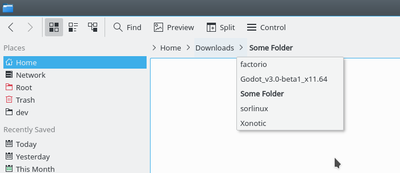
Η κλασσική γραμμή τοποθεσίας που εμφανίζει την πλήρη διαδρομή υπάρχει ακόμα. Για να ενεργοποιήσετε τη συγκεκριμένη μορφή εμφάνισης κάντε δεξί κλικ στη γραμμή τοποθεσίας και επιλέξτε . Αν επιθυμείτε η γραμμή τοποθεσίας να είναι επεξεργάσιμη, πατήστε τη συντόμευση Ctrl + L ή επιλέξτε . Μπορείτε επίσης να κάνετε την γραμμή τοποθεσίας επεξεργάσιμη κάνοντας κλικ στον ελεύθερο χώρο δίπλα στον φάκελο που εμφανίζεται τελευταίος στο στιλ ιχνηλάτησης. Στην περίπτωση που έχετε επιλέξει το επεξεργάσιμο στιλ, στο τέλος της γραμμής τοποθεσίας εμφανίζεται το βελάκι επισήμανσης. Το βελάκι αυτό μπορεί να χρησιμοποιηθεί για να μεταβείτε και πάλι στο στιλ ιχνηλάτησης. Φυσικά, μπορείτε να χρησιμοποιήσετε και το μενού ή τις σχετικές συντομεύσεις.
Διαίρεση προβολής
Ο Dolphin προσφέρει επίσης τη δυνατότητα διαίρεσης της τρέχουσας προβολής των φακέλων σας, με αποτέλεσμα δυο διαφορετικές προβολές φακέλων να εμφανίζονται δίπλα-δίπλα, όπως στον Midnight Commander. Μια πολύ βολική προβολή για να αντιγράφετε ή να μετακινείτε φακέλους από τον έναν φάκελο στον άλλον.
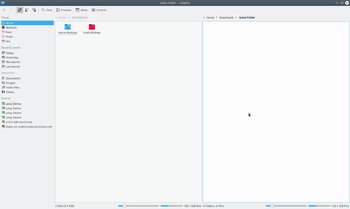
Μπορείτε να πραγματοποιήσετε τη διαίρεση της προβολής κάνοντας κλικ στην επιλογή στη γραμμή εργαλείων, ή, αν έχετε ενεργοποιήσει τη γραμμή μενού, (συντόμευση πληκτρολογίου F3). Για να μεταβείτε και πάλι σε προβολή ενός φακέλου κάντε κλικ στο ή απλά πατήστε F3 και πάλι. Το σχετικό σύμβολο εμφανίζει ποια προβολή πρόκειται να κλείσει. Ανάλογα με την τρέχουσα προβολή, το σύμβολο πλην θα εμφανίζεται είτε στα αριστερά είτε στα δεξιά. Η ενεργή προβολή είναι αυτή που τελικά θα κλείσει. Αυτό είναι πολύ σημαντικό αν χρησιμοποιείτε τις συντομεύσεις του πληκτρολογίου. Υπάρχει επίσης ένα κουμπί στη γραμμή εργαλείων για τη διαίρεση και το κλείσιμο της προβολής. Και αυτό εμφανίζει το σύμβολο πλην, με αποτέλεσμα να είστε σε θέση να γνωρίζετε με ευκολία ποια προβολή πρόκειται να κλείσει.
Κάθε προβολή, φυσικά, έχει τη δική της γραμμή τοποθεσίας και επίσης μπορεί να χρησιμοποιεί διαφορετική λειτουργία προβολής.
Λειτουργία προβολής
Ο Dolphin υποστηρίζει τρεις διαφορετικές λειτουργίες προβολής: "Εικονίδια", "Λεπτομέρειες" και "Σύμπτυξη". Μπορούν να αλλαχτούν επιλέγοντας , μέσω του μενού (αν είναι ενεργοποιημένη η γραμμή μενού) ή μέσω των συντομεύσεων Ctrl+1 (Εικονίδια), Ctrl+2 (Σύμπτυξη) καιCtrl+3 (Λεπτομέρειες). Υπάρχει επίσης το σχετικό εικονίδιο για κάθε λειτουργία στη γραμμή εργαλείων και, το μενού που εμφανίζεται πατώντας το κουμπί ελέγχου, παρέχει το υπό-μενού για να αλλάξετε λειτουργία προβολής.
Εικονίδια
Κάθε αρχείο και φάκελος, στην προβολή"Εικονίδια", αναπαριστάται με ένα εικονίδιο. Εναλλακτικά, αντί του εικονιδίου, παρέχεται η δυνατότητα εμφάνισης της προεπισκόπησης του αρχείου. Η συγκεκριμένη συμπεριφορά μπορεί να απενεργοποιηθεί από το μενού (αν είναι ενεργοποιημένη η γραμμή μενού) ή από το κουμπί της γραμμής εργαλείων. Υπάρχει όριο μεγέθους για την προεπισκόπηση των αρχείων. Το όριο αυτό μπορεί να διαμορφωθεί κατάλληλα από τις επιλέγοντας . Παρέχεται επίσης η δυνατότητα ενσωμάτωσης εικόνων επισκόπησης (thumbnails) στα αρχεία. Στο KDE 4.5 η προεπισκόπηση ενεργοποιείται (κι επίσης καθορίζεται και το μέγιστο μέγεθος) μέσω του . Από την KDE 4.8, οι προαναφερθείσες ρυθμίσεις μπορούν να διαμορφωθούν επιλέγοντας .
Τα αρχεία του ενεργού φακέλου ταξινομούνται αλφαβητικά με βάση τις προκαθορισμένες ρυθμίσεις. Ο τύπος ταξινόμησης μπορεί να αλλαχθεί επιλέγοντας . Παρέχονται τα παρακάτω κριτήρια ταξινόμησης:
- Όνομα
- Μέγεθος
- Ημερομηνία
- Άδειες (δικαιώματα)
- Ιδιοκτήτης
- Ομάδα
- Τύπος
- Προορισμός συνδέσμου
- Διαδρομή
Επίσης, η σειρά ταξινόμησης μπορεί να καθοριστεί επιλέγοντας ή .
Υπάρχει επίσης η δυνατότητα εμφάνισης επιπλέον πληροφοριών κάτω από τα εικονίδια. Αυτό μπορεί να ενεργοποιηθεί/απενεργοποιηθεί επιλέγοντας ή (αν έχετε ενεργοποιημένη τη γραμμή μενού). Τα ίδια κριτήρια με αυτά που παρέχονται για την αναζήτηση μπορούν να χρησιμοποιηθούν κι εδώ.
Μπορείτε να ομαδοποιήσετε τα εικονίδια για να επιτύχετε υψηλότερο βαθμό εποπτείας. Μπορείτε να την ενεργοποιήσετε επιλέγοντας ή (αν είναι ενεργοποιημένη η γραμμή μενού). Τώρα τα εικονίδια είναι ομαδοποιημένα και οι ομάδες διαχωρίζονται από μια οριζόντια γραμμή που έχει σαν ετικέτα το όνομα της ομάδας. Η ομαδοποίηση σχετίζεται με τα επιλεγμένα κριτήρια αναζήτησης.
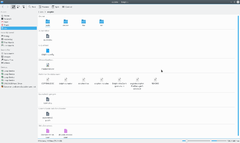
Λεπτομέρειες
Στη λειτουργία προβολής "Λεπτομέρειες" εμφανίζονται, προκαθορισμένα, περισσότερες πληροφορίες σε σχέση με τη λειτουργία "Εικονίδια". Όλα τα αρχεία εμφανίζονται σε έναν πίνακα. Κάνοντας δεξί κλικ στον πίνακα μπορείτε να προσθέσετε επιπλέον στήλες. Οι παρακάτω στήλες είναι διαθέσιμες:
- Μέγεθος
- Ημερομηνία
- Άδειες (δικαιώματα)
- Ιδιοκτήτης
- Ομάδα
- Τύπος
- Προορισμός συνδέσμου
- Διαδρομή
Η στήλη "Όνομα"εμφανίζεται πάντοτε. Κάνοντας κλικ σε μια στήλη, ο πίνακας ταξινομείται ως προς τη στήλη αυτή. Κάνοντας κλικ και πάλι, ο πίνακας ταξινομείται αντιστρόφως.
Από την KDE 4.1 παρέχεται η δυνατότητα της δεντρικής προβολής των φακέλων. Σε αυτή τη λειτουργία το σύμβολο συν εμφανίζεται δίπλα στον φάκελο. Το σύμβολο συν έχει αντικατασταθεί από το > στις νεότερες εκδόσεις του KDE. Κάνοντας κλικ στο σύμβολο αυτό, ο φάκελος αναπτύσσεται και εμφανίζονται τα περιεχόμενα αρχεία και οι φάκελοι, κατά μια εσοχή προς τα δεξιά. Κάνοντας και πάλι κλικ στο σύμβολο, που τώρα είναι το πλην (ή, στις τελευταίες εκδόσεις, ένα βέλος που δείχνει προς τα κάτω), η επέκταση κλείνει. Εννοείται πως η προβολή δέντρου μπορεί να χρησιμοποιηθεί σε όσους φακέλους επιθυμείτε. Στις τελευταίες κυκλοφορίες του KDE, η προβολή δέντρου είναι προκαθορισμένα ενεργοποιημένη, αλλά μπορεί να απενεργοποιηθεί επιλέγοντας και απενεργοποιώντας το .
Στήλες
View mode "Columns" was inspired by the file manager Finder of Mac OS X. Entering a sub folder did not replace the current folder view but the content of the sub folder was listed in an additional column next to the column of the parent folder. This could be used for several hierarchies, so that you could navigate in an easy and fast way in the file system. Since KDE 4.8, view mode "Columns" has been dropped and will not be available in future Dolphin releases.
Setting defaults for all folders
Under (or under the menu item if you have enabled menu bar) you can set any of these attributes to be the default for all folder views.
Panels
Dolphin contains several panels, which can be activated via menu . Each panel can be placed in the left or right docking area. To move a panel you have to unlock panels (right clik on a panel and select ), click on the header and Drag&Drop the panel. The area where the panel will be placed on mouse released is highlighted. It is possible to stack panels on top of each other. In this case the panels are placed into tabs.
In the header of each panel there are two buttons. The button near to the caption undocks the panel. This makes the panel an independent window which "floats" above Dolphin. The window is still combined with Dolphin and cannot be displayed without Dolphin and cannot for example be minimized like normal windows. By clicking the button again the panel is docked again. The second button will close the panel.
Non Modal Dialogs
When Moving, Copying or Deleting files/directories the dialog disappears even when the operation has not yet completed. A progress bar then appears in the bottom right of the screen, this then disappears also, if you want see the progress you need to click a small (i) information icon in the system tray.
Places
Dolphin contains a new kind of bookmarks Places. These are displayed in a panel which can be activated via (keyboard shortcut F9). The default Places are identical to the ones shown in the category Computer of the K-Menu Kickoff.
By clicking one of these places it will be opened in the current folder view. The context menu offers the possibility to edit the places or to remove them again. It is also possible to hide entries temporarily.
The context menu of a folder can be used to add this folder an another entry to the Places panel. Therefore there is a menu item . You can also Drag&Drop a folder to the Places panel.
The places panel also contains entries to connected removable devices like USB-keys or CDs. A small plug icon indicates if the device is mounted. The context menu offers the possibility to unmount the device.
The places are used as the basis in the breadcrumb navigation bar. Each address is shown in relation to the nearest parent folder which is one of the places.
Information
The information panel can be activated via (keyboard shortcut F11). This panel displays a preview or an icon of the currently selected file/folder or of the file/folder below the mouse cursor. Some additional information like change date or size to the file/folder is displayed as well.
The information panel offers the possibility to rate files, add a comment or tag a file. This is one of the interfaces to the semantic Desktop Nepomuk which provides the advantages of the semantic web for the desktop. Starting from KDE 4.2 it is possible to search for the semantic links given by the tags.
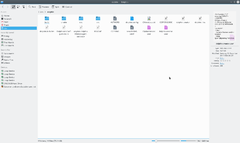
Folders
A panel providing a tree structure for the file system can be displayed via (keyboard shortcut F7). The tree structure offers the possibility by clicking the > and ˇ signs to expand/collapse sub folders. By clicking on one of the folders the content will be displayed in the current view.
Terminal
The terminal emulator Konsole can be displayed directly in Dolphin via (keyboard shortcut F4). This makes it possible to use shell commands directly in Dolphin. The terminal is opened in the folder which is displayed in the current view. Shift + F4 opens Konsole in new window.
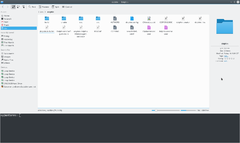
External links
Road to KDE 4: Dolphin and Konqueror
Ars Technica: A First Look at Dolphin
Youtube - KDE 4 rev 680445 - Dolphin
Introducing KDE 4 Blog - Dolphin
Bookmarks and Places
In KDE3 you could create bookmarks in Konqueror, but they were not available to any other application. KDE SC 4.x opens up a great deal more flexibility - but that inevitably means more complication. In fact KDE SC 4 has three classes of Bookmarks, which need to be differentiated. They reside in different files, and have different functions.
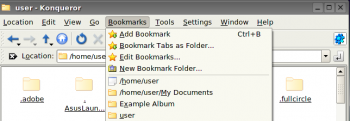
Three kinds of bookmark
First, there is the set of bookmarks available only to Konqueror - web bookmarks. These are stored in ~/.kde/share/apps/konqueror/bookmarks.xml. Then there is a set which Dolphin calls Places. This set is available to all applications as well as the Dolphin file manager. Every time you use you will see this set. The third set of bookmarks are Application Bookmarks. These share one file, regardless of the application that set them, and are available to all applications, unless you restrain them to a specific application. More of that later.
Enable bookmarks
In most distros Bookmarks are not enabled by default. In order to use bookmarks we first have to enable them. Open a in most KDE applications and you will see, at the right-hand edge of the icon panel, a spanner or wrench. From the drop-down list, choose .
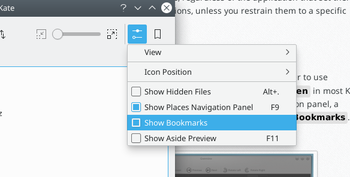
There is a default set of Places -
- Home
- Network
- Root
- Trash
but you can add other places. In Dolphin, right-click on a folder and select , or just drag a folder onto Places.
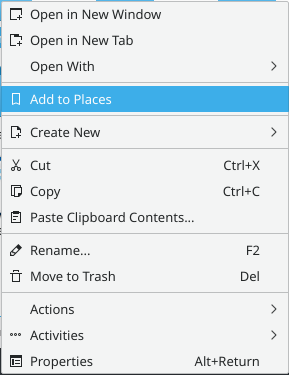
By default this "Place" will be visible in all applications. If you want to keep it constrained to Dolphin, you need to right-click on the new name in the Places list, where you will find the option to Edit it. There is a check-box for .
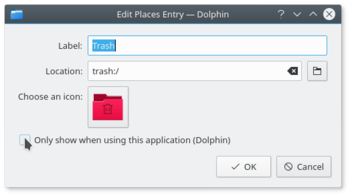
You can see the result of that command if you read ~/.kde4/share/apps/kfileplaces/bookmarks.xml.
In some applications too there is an option in the File menu to add a folder to Places. At this stage, however, applications vary in which features are available. The important thing to remember is that the default is for Places items to be available to all applications in the dialogue.
Bookmarks in applications
This is the second class of bookmarks. Remember opening and using the spanner/wrench? Next to it is a yellow star. This is the bookmark management menu.
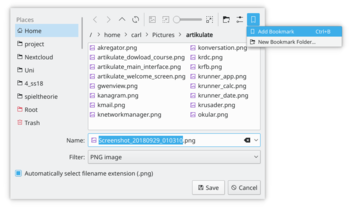
Here you can define bookmarks that will be visible in the same menu on any application. They are stored in one file, ~/.kde4/share/apps/kfile/bookmarks.xml, which is used by all applications having that menu.
Constraining to one application
Some applications allow you to edit items in the Places menu. For instance, if in Gwenview you right click on a folder in Places you can set an option to .
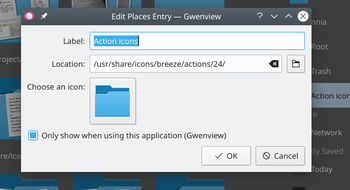
If you need to constrain to an application that does not yet allow you to do that, the only way left is to edit the file ~/.kde/share/apps/kfile/bookmarks.xml. Immediately before the </metadata> tag you will need to add the line
<OnlyInApp>appname</OnlyInApp>
Archive Management in Dolphin
Managing archives now becomes simple. In any directory in Dolphin, highlight the files that you want to compress, and right-click. Here, using the Compress option, you can elect to create a RAR archive, a Gzipped tar archive, or define another compression mode that you have already set up.
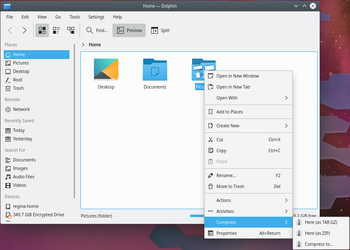
Similarly, if you right-click on an existing archived file you get a range of actions added to the right-click menu. You can extract the archive to the current folder, to an autodetected subfolder or to another place of your choosing.
Should you wish to add files to an existing archive, you can choose .
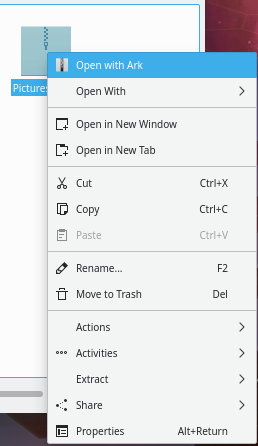
More Cool Actions
Change a File Association on-the-fly
Have you ever wanted to open a file, only to find that it is associated with an application that is not of your choice? You can, of course, alter this in . But Dolphin and Konqueror offer you a quick and cool method for changing a single association.
Right-click on the file and select . The first line there is descriptive, something like:
Type: XML document
At the same level, on the right, there is a spanner (wrench). Click on that and you can add or change an association.
Similarly, by working on a folder, you can change the default file manager to/from Konqueror, if you choose, or add another image browser to the possible associations.
The sub-menu opens up a whole lot more cool things to do from Dolphin. Some possibilities only appear when applicable to the file you have selected. Some of the options are
- Convert an image file to a different format
- Preview the file
- Download a remote file with KGet
- Sign and/or encrypt the file, according to the encryption software installed
Encode and copy audio CD tracks
- Insert an audio CD
- Navigate to this CD in Dolphin: it must appear as "Volume" in your Dolphin 'Places' or you can reach it by typing audiocd:/ in the address bar.
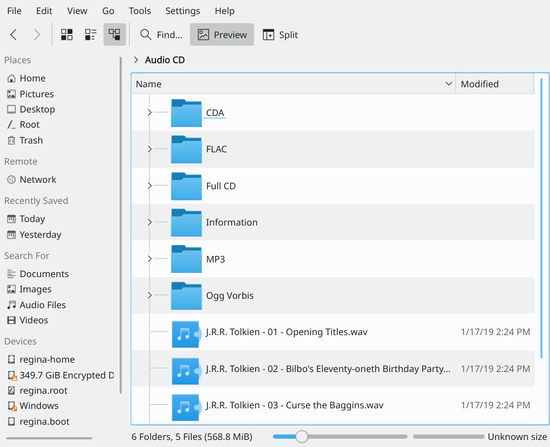
You now notice that Dolphin is proposing a WAV file for each track, plus:
- a CDA folder containing indexing information in the usual CDA format.
- a Whole CD folder, containing one file for each format (.cda, .flac, .mp3, .ogg, .wav) holding all the tracks
- a FLAC folder, containing the tracks encoded into FLAC format (lossless information format)
- an Information folder containing the CDDB informations
- an MP3 folder, containing all the tracks in MP3 format
- a Ogg Vorbis folder, containing the tracks encoded in OGG format
You then just have to copy the folder of your choice, in your preferred format to obtain the relative encoded version of your CD!
Have your recent files as home
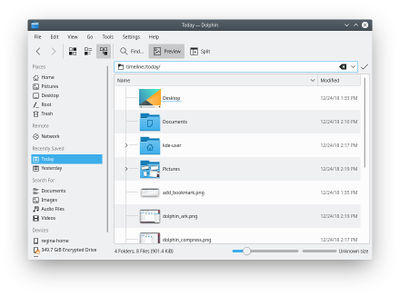
Dolphin has access to a large number of file transfer protocols (KIO Slaves). One of those is provided by the KDE semantic search system (Nepomuk). Nepomuk offers a transfer protocol named history. You can navigate to it by entering timeline:/ in the location bar.
One particularly neat thing there is the ability to have the Today folder from the timeline:/ protocol in the Places sidebar (you can just drag it there!). You can then change the name and icon (do a right click on the new Today entry and choose ).
It could be very useful to have this view of recently used files immediately when you start Dolphin. Unfortunately, as of Dolphin 2.1 (part of KDE SC 4.9) this is not possible without editing the Dolphin configuration file. See this blog for more details on that.
To edit the configuration file, first close all Dolphin windows. Dolphin will save its configuration upon closing, overwriting any changes you might make!
Then use KRunner (Alt + F2) to edit ~/.kde4/share/config/dolphinrc (or ~/.kde/share/config/dolphinrc, depending on your distribution) with KWrite as follows: kwrite ~/.kde4/share/config/dolphinrc. You can of course use any other editor as well, like Kate. In the configuration file, locate the [General] section to edit the HomeUrl into: HomeUrl=timeline:/today and save the file. You should now have the today view as default and have the files you're most often looking for at your fingertips!




